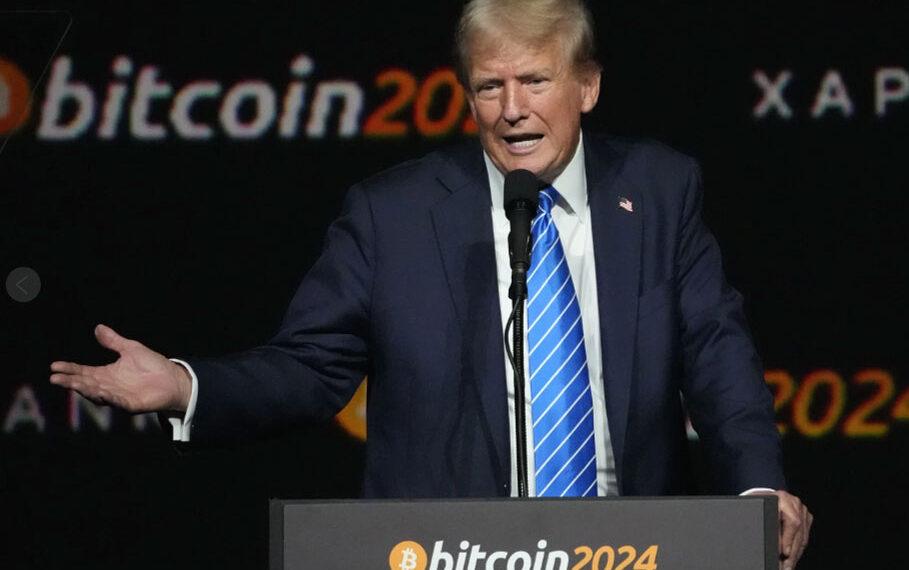Bitcoin Hits New Record High After Trump’s Election Victory: What You Need to Know
Bitcoin reached a new record high of over $87,000 on Monday, fueled by a post-election rally. As of 3:45 p.m. ET, the world’s largest cryptocurrency stood at $87,083, marking a 28% increase in just the past week.
This surge follows Donald Trump’s victory in the U.S. presidential election, which many analysts believe has sparked a renewed interest in cryptocurrency. There is optimism within the crypto industry that Trump’s administration will provide more regulatory clarity and be more supportive of digital currencies.
However, while the rally has sparked excitement, experts continue to warn of the risks involved in cryptocurrency investment, given its volatility. Here’s a breakdown of the situation.
What Is Cryptocurrency?
Cryptocurrency is digital money that operates through an online network without a central authority. This means it’s not backed by any government or banking institution, and transactions are recorded on a blockchain. Bitcoin is the largest and oldest cryptocurrency, but other digital assets like Ethereum, Tether, and Dogecoin have also gained popularity. Cryptocurrencies are often seen as a “digital alternative” to traditional currencies, but they can be highly volatile and influenced by larger market forces.
Why Are Bitcoin and Other Crypto Assets Rising Now?
The recent surge in crypto prices is largely attributed to the outcome of the election. While Trump was initially skeptical of cryptocurrencies, he has since embraced them. During his campaign, Trump pledged to make the U.S. “the crypto capital of the planet” and even accepted campaign donations in cryptocurrency. His administration is expected to be more supportive of crypto, which many see as a positive shift.
Crypto industry insiders are hopeful that Trump’s victory will lead to legislative and regulatory changes that benefit the industry. For instance, Trump has promised to remove SEC Chairman Gary Gensler, who has been leading the government’s crackdown on crypto, in favor of a more lenient regulatory approach.
“Crypto rallied as Election Day progressed into the night and it became clear that Trump would emerge victorious,” analysts from Citi noted, pointing to the market’s positive reaction to Trump being seen as “crypto-friendly.”
Additionally, the approval of spot bitcoin exchange-traded funds (ETFs) in January has significantly contributed to bitcoin’s price rise. These ETFs have been the primary driver of bitcoin returns, and large inflows into them have continued since the election.
What Are the Risks?
Despite the recent gains, the crypto market remains volatile. Bitcoin has a history of dramatic price swings, which can happen suddenly. For instance, during the early days of the COVID-19 pandemic, bitcoin’s price was just over $5,000 but surged to nearly $69,000 in 2021 before crashing amid inflation-fighting measures by the Federal Reserve. In 2022, the collapse of FTX, a major crypto exchange, further undermined confidence in the market.
In early 2023, bitcoin was trading below $17,000, but a resurgence in demand, particularly after the approval of spot ETFs, has fueled this year’s rally. However, experts caution that cryptocurrencies can be unpredictable, and investors should be prepared for volatility.
“Investors should only invest in crypto with money they can afford to lose,” advised Susannah Streeter, head of money and markets at Hargreaves Lansdown.
Environmental Impact of Cryptocurrency Mining
Bitcoin mining, which is the process used to generate new bitcoins, has raised environmental concerns due to its high energy consumption. Mining operations often rely on energy sources like coal and natural gas, which have significant carbon footprints. A recent study by the United Nations University and Earth’s Future journal revealed that bitcoin mining in 2020-2021 produced emissions equivalent to burning 84 billion pounds of coal.
In the U.S., the rapid growth of crypto mining has prompted concerns from grid planners about rising electricity demand. Estimates suggest that crypto mining may account for between 0.6% and 2.3% of U.S. electricity consumption.
However, there has been a push for cleaner energy sources in recent years, with some crypto mining operations shifting toward renewable energy to address these environmental concerns.
Conclusion
While the post-election rally in crypto assets, particularly bitcoin, is fueling optimism, the volatile nature of the market and environmental concerns continue to pose risks. As cryptocurrency gains more attention and support, investors should approach with caution, mindful of the potential for significant swings in value and the broader impact of mining operations.
As with any investment, it’s essential to stay informed and prepared for the unpredictability of the market.
This article was rewritten by JournosNews.com based on verified reporting from trusted sources. The content has been independently reviewed, fact-checked, and edited for accuracy, neutrality, tone, and global readability in accordance with Google News and AdSense standards.
All opinions, quotes, or statements from contributors, experts, or sourced organizations do not necessarily reflect the views of JournosNews.com. JournosNews.com maintains full editorial independence from any external funders, sponsors, or organizations.
Stay informed with JournosNews.com — your trusted source for verified global reporting and in-depth analysis. Follow us on Google News, BlueSky, and X for real-time updates.














